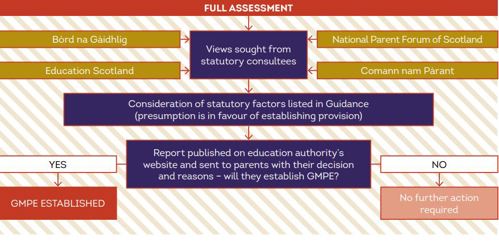Gaelic education
Education (Scotland) Act 2016 - Gaelic Education
East Dunbartonshire Council is committed to the promotion and support of Gaelic Medium Education.
Currently, provision is available from nursery through to Primary 7 at Meadowburn Primary School and at Bishopbriggs Academy for learners of secondary school age.
Bòrd na Gàidhlig has produced Statutory Guidance on Gaelic Education. This contains important information regarding the assessment processes for Gaelic Medium Education in the Primary School. The Guidance is in two parts - Part 1 provides guidance on the process for requesting an assessment of the need for the provision of Gaelic Medium Primary Education (GMPE) from an education authority and the duty to encourage and support Gaelic education. Part 2 provides Statutory Guidance for Education Authorities, parents and anyone else with an interest in Gaelic Education bringing together research, experience and best practice.
The guidance can be found on Bòrd na Gàidhlig’s website. These provisions came into force on 1 February 2017.
Gaelic Medium Education in the Primary School within East Dunbartonshire Council
The Gaelic Medium Unit, based at Meadowburn Primary School in Bishopbriggs, offers its pupils from Nursery right through to Primary 7, the opportunity of being educated through the medium of Gaelic.
These pupils leave Meadowburn Primary School with the advantage of having become proficient in two languages, Gaelic and English.
As a parent/carer you have the right to apply for a place at Meadowburn Primary School’s Gaelic Unit. In March 2018, following consultation, changes to the catchment area for Gaelic Medium Primary Education were made which means that the catchment for the Gaelic Unit at Meadowburn Primary School is now the whole of East Dunbartonshire. This ensures that children in the primary stages who live in East Dunbartonshire are able to register for Gaelic Medium Primary Education without the barrier of having to submit a placing request. If you live in East Dunbartonshire, this would involve registering your child at Meadowburn Primary School during registration week in the January before they are due to start in Primary 1. Visit the Primary School Registration page to register your child at Meadowburn Primary School. If you wish to register your child after registration week, you should contact Meadowburn PS directly. At a later point, if you wish to enrol your child at Bishopbriggs Academy and live outwith the Bishopbriggs Academy catchment area you have the right to put in a placing request.
Applying for a nursery place at Meadowburn Gaelic Nursery
All children aged three and four and eligible children aged two in Scotland have a statutory entitlement to 1140 hours of funded early learning and childcare. Parents/Carers have the right to apply for a place at Meadowburn Primary School’s Gaelic Early Years Centre where children will learn in the medium of Gaelic. The delivery model for Meadowburn Gaelic Early Years Centre is 9am to 3pm, Monday to Friday, during term time. For more information on early years entitlement and how to apply, visit the Early years - how to appl web page.
Request for an assessment area for Gaelic medium primary education within East Dunbartonshire
Legislation gives parents the right to request an assessment for the need for Gaelic medium education (GMPE) from the local authority. At present, GMPE is provided in East Dunbartonshire Council within Meadowburn Primary. However, if demand were to increase to a level which could not be accommodated within Meadowburn, then a second assessment area may require to be detailed.
Guidance on how to proceed with the submission of a request to East Dunbartonshire Council and assess the need for GMPE, and an explanation of how the process works can be accessed through the links below. There is also an explanation of what Parents can expect if they submit a request to East Dunbartonshire Council to assess the need for GMPE.
Gaelic medium primary education process



Gaelic medium primary education summary for parents
Do you have a child below school age who has not started school?
Do you wish your child to be educated in GMPE?
Is there evidence of further demand for GMPE in your education authority area? (Bord na Gaidhlig or Comann nam Parant may be able to help with this information)
If your answer to all of the above questions is 'Yes', you may submit a request to assess the need for GMPE to your education authority. (Guidance on what to include can be found in Paragraphs 1.7-1.9)
The education authority will carry out an Initial Assessment and will write back to you within six weeks of receiving your request.
If the initial assessment finds potential demand, the education authority will then carry out a full assessment (or use its discretion to establish GMPE) which will consider any factors which may affect the decision to secure GMPE. (Factors are listed in Paragraph 1.52).
The education authority will prepare a report within 10 weeks of beginning the Full Assessment, setting out:
- Its decision
- Its reasons for reaching the decision
- When it intends to commence GMPE, if this decision has been reached.
As the parent who requested GMPE, you will receive a copy of this report. If GMPE provision is to be secured, your education authority will let you know how to proceed.
It should be noted that a placing request will still need to be made separately for your child in relation to any eventual provision.
